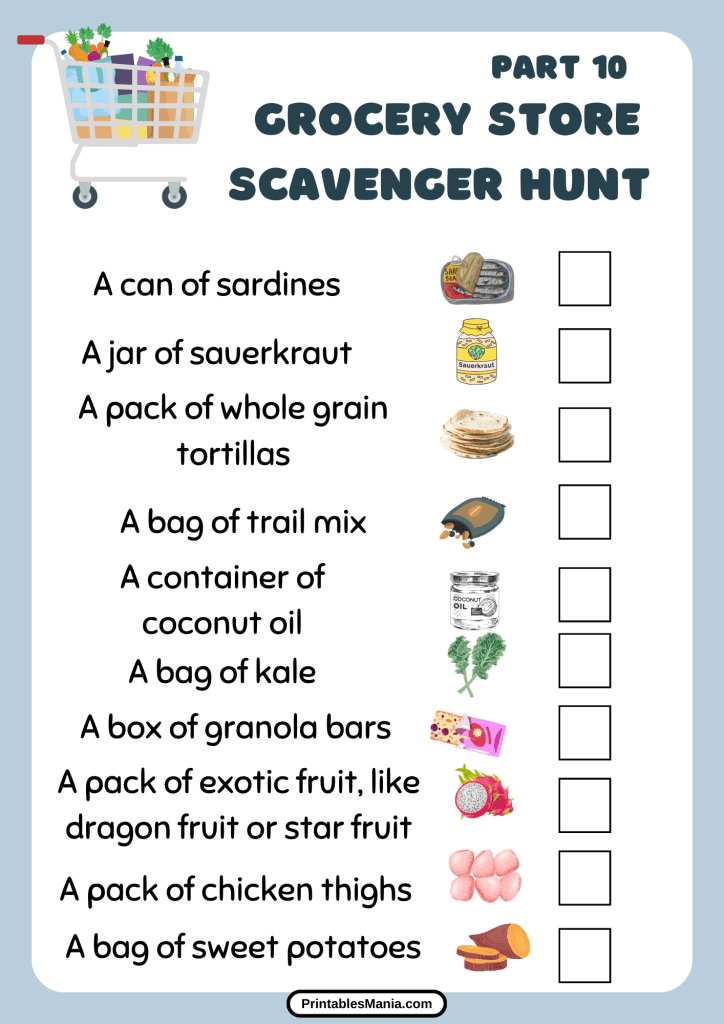A Grocery Store Scavenger Hunt is a fun and educational game designed to make shopping trips more exciting and informative. Participants use a list of items to find throughout the store, learning about different foods, nutritional information, and smart shopping strategies along the way. It’s perfect for families, school groups, or anyone looking to add a twist to their routine grocery shopping experience.
How to Play
- Prepare Your List: Start with a predefined list of items that include a variety of foods. You can use our suggested lists or create your own based on the themes or educational goals you have in mind.
- Set the Rules: Decide if participants will play individually or in teams, set time limits, and explain any points or bonus challenges involved.
- Go Hunting: Armed with the list and a shopping cart, participants navigate the store to locate each item. They can check items off as they find them, and take notes or photos if required by the game rules.
- Learn and Have Fun: Encourage participants to read product labels and learn about the items they are searching for. This can include nutritional content, price comparisons, or fun facts about the origins of certain foods.
- Celebrate: Once the scavenger hunt is complete, gather to discuss the items found, share interesting discoveries, and maybe enjoy a treat bought during the hunt.
Benefits of Participating
Grocery store scavenger hunts can be more than just fun. They are educational tools that help participants learn about food nutrition, budgeting, and the importance of diverse dietary choices. They also enhance critical thinking and problem-solving skills as participants decide the most efficient way to find all items.
Join us as we turn the grocery store into a playground of discovery and learning!










Tips for a Successful Hunt
Participating in a grocery store scavenger hunt can be both fun and challenging. To ensure a smooth and enjoyable experience, consider the following tips:
- Plan Ahead: Before the hunt, review the list of items to familiarize yourself with what needs to be found. This can help in strategizing the most efficient path through the store.
- Use the Store Map: Many grocery stores have maps available at the entrance or online. Utilizing a map can help you quickly locate specific sections and save time.
- Read Labels Carefully: Part of the scavenger hunt can include finding items with specific nutritional content or ingredients. Reading labels not only helps in successfully finding the right items but also in learning about what you’re consuming.
- Stay Organized: Keep your list handy, and mark off items as you find them. This keeps you on track and ensures you don’t overlook any items.
- Respect Store Rules and Other Shoppers: Remember to be courteous to other shoppers. Avoid blocking aisles, and handle products with care.
- Time Management: If you’re on a timed challenge, keep an eye on the clock but also ensure you enjoy the hunt. It’s about having fun, not just racing through the store.
Educational Focus
A grocery store scavenger hunt isn’t just an entertaining activity—it’s also a powerful educational tool, especially for young participants. Here’s how it can contribute to learning:
- Nutritional Education: Participants can learn to identify healthier food choices by comparing nutritional labels, understanding food groups, and selecting fresh over processed items.
- Budgeting Skills: Incorporate budgeting into the scavenger hunt by setting a spending limit for the items on the list. This teaches participants to compare prices and calculate total costs, fostering financial literacy from a young age.
- Cultural Awareness: Including items from various cuisines can expose participants to different cultures and culinary traditions, encouraging a broader palate and greater cultural appreciation.
- Environmental Impact: Teach participants about sustainability by including items that are organic, locally sourced, or come in eco-friendly packaging. Discuss the impact of these choices on the environment to promote eco-conscious behaviors.
- Reading and Comprehension Skills: For younger participants, reading item names and understanding store signage can be great practice in literacy and comprehension.
- Problem Solving: Deciding how to find items and navigate the store efficiently requires critical thinking and problem-solving, skills that are beneficial both in and out of academic settings.
By focusing on these educational aspects, a grocery store scavenger hunt can be transformed into a valuable learning experience that teaches important life skills and lessons in an interactive and memorable way.







